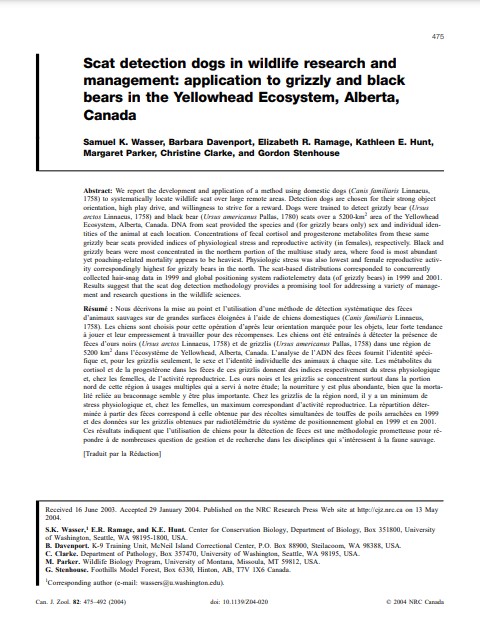Scat detection dogs in wildlife research and management: application to grizzly and black bears in the Yellowhead Ecosystem, Alberta, Canada
Bosque Modelo:
Foothills
Temática:
Conservación
Tipo de documento:
Artículo científico
Resumen
We report the development and application of a method using domestic dogs (Canis familiaris Linnaeus, 1758) to systematically locate wildlife scat over large remote areas. Detection dogs are chosen for their strong object orientation, high play drive, and willingness to strive for a reward. Dogs were trained to detect grizzly bear (Ursus arctos Linnaeus, 1758) and black bear (Ursus americanus Pallas, 1780) scats over a 5200-km2 area of the Yellowhead Ecosystem, Alberta, Canada. DNA from scat provided the species and (for grizzly bears only) sex and individual identities of the animal at each location. Concentrations of fecal cortisol and progesterone metabolites from these same grizzly bear scats provided indices of physiological stress and reproductive activity (in females), respectively. Black and grizzly bears were most concentrated in the northern portion of the multiuse study area, where food is most abundant yet poaching-related mortality appears to be heaviest. Physiologic stress was also lowest and female reproductive activity correspondingly highest for grizzly bears in the north. The scat-based distributions corresponded to concurrently collected hair-snag data in 1999 and global positioning system radiotelemetry data (of grizzly bears) in 1999 and 2001. Results suggest that the scat dog detection methodology provides a promising tool for addressing a variety of management and research questions in the wildlife sciences.
Información Bibliográfica
Autor:
Wasser, SK, B Davenport, ER Ramage, KE Hunt, M Parker, C Clarke and G Stenhouse.
Revista:
Canadian Journal of Zoology
Año:
2004
N°:
-
País :
Canadá
Páginas:
475 - 492
Volumen:
82
Idioma:
Ingles
Palabras claves
Grizzly Bear, Ursus arctos, home range, movement, habitat





